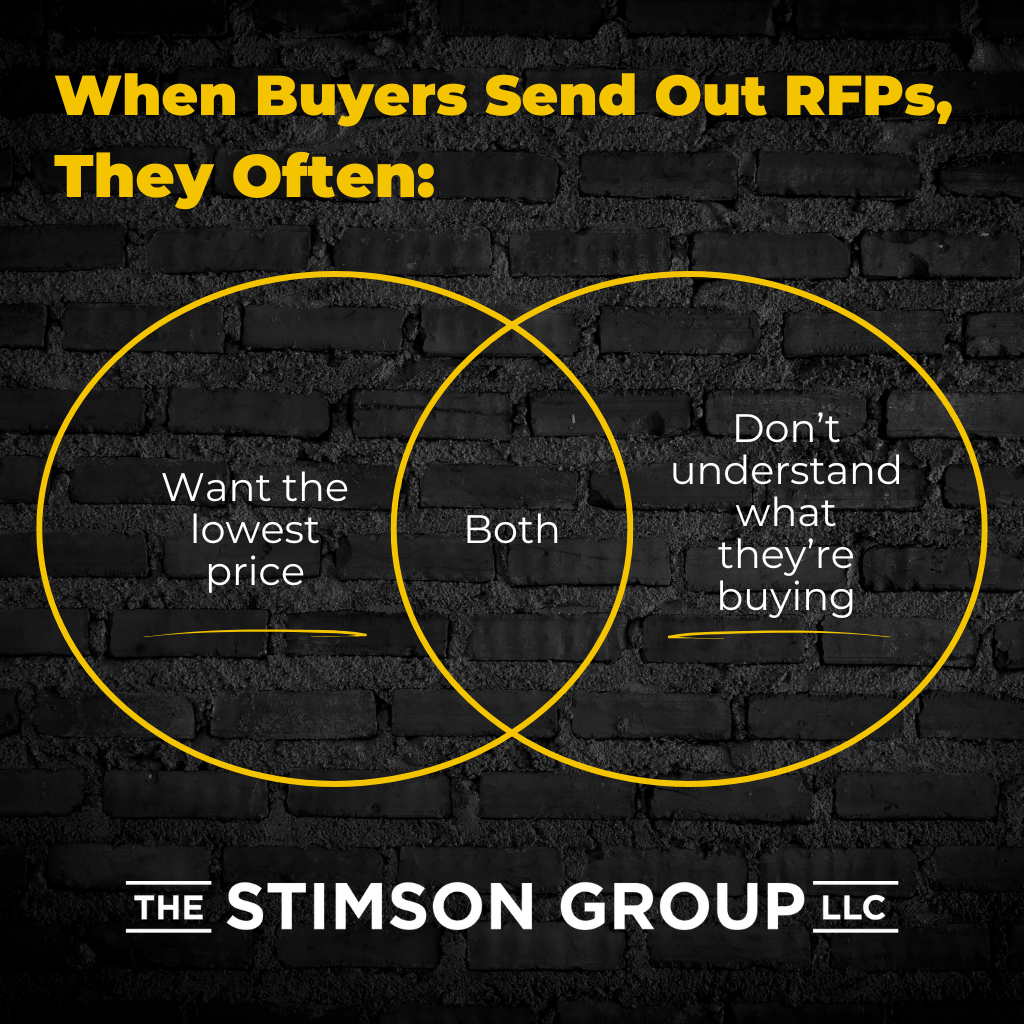
Listen instead on your Monday Morning Drive:
I used to live for RFPs.
Requests for proposals were my mainstay. I didn’t have to do any sales work. The fax machine went off, the emails came in (sometimes they showed up in the mail), and I’d crank out a proposal and send it back.
It was so easy doing business back in the day.
But over time, as we’ve automated more processes, it’s become easier to get RFPs to multiple people. Buyers — particularly procurement-based buyers — started betting that somebody would lowball the price.

The Problem With RFPs
When buyers send out RFPs, they often:
- Want the lowest price, or…
- Don’t understand what they’re buying, or…
- Both
Number two is the most common. Buyers don’t know how to determine their budget or needs. They’re not experts in what you do. That’s why they need you — which is exactly why the RFP system is out of place.
It doesn’t make sense. The buyer expects someone else to be the expert for them for free, based on terminology they picked up from a proposal somewhere or heard from someone.
A Real-World Example
A few years ago, before the pandemic, a major pharmaceutical company asked to hire me as a consultant. They had many events: product rollouts, sales training, medical training, continuing education — a massive portfolio of work.
They wanted me to advise them on “how to stop their AV suppliers from making so much money.” They were comparing the purchase price to rental costs for consumer items like large-screen TVs and cherry-picking quotes they’d gotten over the phone from wholesale rental suppliers about what a wireless microphone should cost.
I turned them down for three reasons:
- Their premise was wrong. A little data doesn’t indicate how much money AV suppliers make for gathering equipment, hiring talent, building cases, and doing maintenance, trucking, and everything else involved in highly complex deals.
- The outcome wouldn’t be durable. The AV suppliers would either change how they make money or go out of business. There would be fewer suppliers, and the buyers would have even less control over the marketplace.
- You can’t fix stupid. Life is too short to work with people who think they’re smart but aren’t. This company asked the wrong questions and tried to solve the wrong problems.
The Real Issue With Procurement
Buyers who rely on RFPs and procurement tactics are missing the point. Your customers think you know what your profit number is.
They have no idea you’re guessing a wide range of outcomes and manipulating multiple variables without any true science behind it. We have no idea where our pricing comes from. We make it up. We move components around until we arrive at a number we think the customer will buy.
Buyers think you know what you’re doing and that you’re protecting your huge profit margin by moving numbers around. Their requests for transparency are feeble attempts to expose your math so they can see how much money you actually make and whether you “deserve it.”
But what business is it of theirs? If you do better work, buy smarter, and operate more efficiently than your competitors, why shouldn’t you make more money?
How to Help Buyers Do Better
Your job is to help buyers spend their budget wisely. Explain that to them. Tell them you don’t care what their budget is.
When you see an RFP and decide, “This is a $500,000 show,” everything you do after that is for a $500,000 win. But you might initially be disappointed if the buyer has a $150,000 budget.
There’s a budget that’s too small for you to work with. I don’t know what that number is for you, and I don’t believe we should set project minimums, but you know what it costs to meet base requirements.
If the buyer’s budget is $5,000, wouldn’t it be good to know that before you write a $50,000 proposal?
I know what you’re thinking: You always ask buyers to give you their budget, and they either say they don’t know, or they want to see what you come up with. If they don’t know their budget, that’s not a problem.
This is why it’s important to keep a resource of sample events and sample budget ranges to share.

A Different Approach
No bride picks out table decorations for her wedding dinner with a budget. Instead, she leads with an expectation of what she wants the wedding dinner to look like.
The helpful rental agent says, “We can arrange that table, depending on which centerpiece you choose, for $50–$150 per table.”
We can give that information, too. Every service business built around the rental concept can give a buyer a budget range.
If the buyer wants your best solution at your best price, there’s only one way to get that proposal from you: give you a budget. If they don’t know their budget, your job is to help dial them into that budget.
If they want you to lead them on a journey to discovering their budget, start the billing clock: “Here’s our budget discovery process: We’ll brainstorm your needs, venue, attendees, schedule, etc. We’ll make recommendations. The fee for this service is $10,000 plus expenses.”
Ninety percent of the time, this isn’t what they need. Just use your master selling skills to dial in their tastes, explain the factors affecting their costs, and give them a budget range.
This allows them to get their act together and say, “We’ve decided to spend this much money, and we really like that idea you gave us. Can we make that work?”
That’s the conversation you want to have in 2025. Stop being an order taker. Make that resolution now.





Leave a Reply